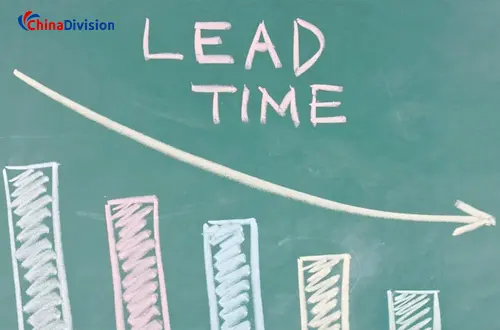How to Shorten the Lead Time in Inventory Management?
Long lead times can lead to out-of-stocks, delayed deliveries, and lost sales, while poor lead time management can lead to inflated storage costs and tie up working capital. Lead time has become a key indicator affecting inventory turnover, customer satisfaction, and operational efficiency. Especially for cross-border e-commerce sellers and B2B companies, understanding and optimizing Lead Time can not only improve order fulfillment speed, but also seize opportunities in the supply chain.
Table of Contents
- What is lead time in inventory management?
- What is the lead time for inventory and transportation?
- Main types of delivery time
- What factors affect Lead Time?
- Scientific calculation of total lead time
- How to reduce lead time: 7 proven strategies
- Lead Time vs. Delivery Time: What’s the difference?
- FAQ: Learn more about shortening lead time
- How does Chinadivision help companies achieve Lead Time Reduction?
As an international order fulfillment expert, Chinadivision has helped hundreds of companies optimize their supply chains by shortening lead times and improving inventory efficiency. In this guide, we will take a deep look at what lead time means, its importance, and how to shorten lead times using proven strategies and our global fulfillment services.
What is lead time in inventory management?
Lead time refers to the total time between placing an order and the goods being available for use or sale. In inventory management, lead time covers every link such as order processing, production or picking, packaging, transportation, customs clearance and warehouse management until the product is ready to be delivered to the customer or enter the next production stage.

What is the lead time for inventory and transportation?
Lead time refers to the total time required for an order from order placement to delivery, including: production time + transportation time + customs clearance time + warehouse processing time.
In inventory management, it usually covers the following stages:
Procurement Lead Time: The time from placing a purchase order to supplier delivery
Production Lead Time: The manufacturing time from raw materials to finished products
Shipping Lead Time: The transportation time from delivery to customer receipt
Warehousing and fulfillment time: The time from goods entering the warehouse to order packaging and shipment
Main types of delivery time:
Supplier delivery time: The time from placing an order to supplier delivery.
Production lead time: The time required to manufacture goods (if applicable).
Shipping lead time: The transportation time from warehouse to customer.
Order processing lead time: the time it takes to pick, pack, and ship an order internally.
Why is lead time so important? Five key pain points for global businesses
Out-of-stocks and lost sales: Longer lead times increase the risk of running out of inventory before replenishment.
Higher holding costs: Excessive safety stock to compensate for longer lead times ties up cash and increases storage costs.
Poor customer experience: Delayed deliveries lead to disappointed buyers and negative reviews.
Inflexible supply chain: Slow lead times make it more difficult to adapt to demand spikes or market changes.
Competitive disadvantage: Competitors with shorter lead times can complete orders faster, thereby capturing market share.
What factors affect Lead Time?
Supplier responsiveness: Long procurement cycles directly extend Lead Time
Production scheduling and capacity: Production bottlenecks or raw material shortages can cause delays
International logistics uncertainty: Customs clearance, weather, port congestion, etc. can all affect shipping time
Warehousing and fulfillment efficiency: Whether the picking, packing, and shipping processes are efficient directly affects the last mile speed
Order processing time: Slow internal fulfillment increases time. Automate picking/packing with Chinadivision’s warehouse management system.
Demand forecasting: Forecast errors can lead to rushed orders. Align orders with demand patterns using AI-driven forecasting tools.
Scientific calculation of total lead time
Total lead time LT = Procurement LT + Transportation LT + Customs clearance LT + Shelf LT
Procurement LT: Number of days from order confirmation to factory shipment
Transportation LT: First-leg + last-leg transportation time (sea/air/rail)
Customs clearance LT: Average processing time of customs in the destination country
Shelf LT: Time taken from warehouse signing to saleable status
How to calculate lead time in inventory management
To measure and improve lead time, use the following formula:
Total lead time = Supplier lead time + Production lead time + Shipping lead time + Order processing time
How to reduce lead time: 7 proven strategies
Work with local suppliers
Sourcing from suppliers close to your warehouse can reduce shipping time.
Use regional warehousing
Store inventory in multiple global warehouses (e.g. EU, US, Asia) and you can ship from the closest location. Chinadivision’s network can reduce shipping lead times by up to 70% for cross-border sellers.
Automated Order Processing
Manual picking, packing, and shipping can increase delivery times. Chinadivision’s automated warehouses can process orders within 24 hours, significantly reducing order fulfillment lead times.
Improved Demand Forecasting
Accurate forecasting can avoid last-minute rush orders. Use machine learning tools to analyze sales trends and adjust reorder points based on lead time requirements.
Negotiate with Suppliers
Request shorter production cycles or faster shipments. For example, ask suppliers to split goods into smaller batches and ship more frequently.
Optimize Inventory Levels
Balance safety stock and lead time requirements. Chinadivision’s inventory optimization software recommends replenishment quantities based on real-time lead time data.
Choose Faster Shipping Methods
Although air freight or express delivery is more expensive, it can reduce shipping cycles by 80% for rush orders. For high-value or time-sensitive products, use air freight or express delivery strategically.
Shortening lead time not only improves customer satisfaction, but also brings the following benefits:
Reduced inventory costs and capital tie-up
Increased order fulfillment flexibility and responsiveness
Reduces the risk of returns and negative reviews due to delays
Lead Time vs. Delivery Time: What’s the difference?
Lead Time: Lead Time is a time period that emphasizes the entire order fulfillment cycle. The total time from order placement to customer delivery (including supplier, production and fulfillment delays). Supply Chain Preparation Time (from order receipt to shipment preparation completion)
Delivery Time: Delivery Time is a point in time that refers to the specific date the customer receives the goods. The time from shipment to customer (excluding supplier/production delivery time). Logistics distribution time (from shipment to customer receipt)
FAQ: Learn more about shortening lead time
Does shortening lead time really reduce warehousing costs?
Yes! Shorter lead times mean you need less safety stock, which frees up warehouse space and reduces inventory costs. Chinadivision’s customers typically reduce inventory costs by 20-30% after optimizing lead times.
Does shortening lead times always save me money?
While shortening lead times often results in cost savings (e.g., less safety stock, fewer expedited shipments), there are some drawbacks. For example, using air freight can significantly shorten lead times, but shipping costs will also increase. The key is to find the best balance for your specific products and business model.
How does Chinadivision help companies achieve Lead Time Reduction?
As a professional international order fulfillment service provider, Chinadivision provides one-stop warehousing and fulfillment solutions to help e-commerce sellers and B2B companies effectively shorten lead times:
Warehousing advantages
Chinese warehouses close to the source of manufacturing, reducing transportation time
Intelligent inventory management system, real-time inventory dynamics
Fulfillment efficiency
Automated picking and packing processes to increase delivery speed
Work with multiple international logistics companies to optimize transportation routes and costs
Customer customization services
Support Shopify, WooCommerce and other platform docking
Provide value-added services such as order tracking and return processing
Excessive lead times will cost you money, customers, and peace of mind. If you are struggling to cope with unpredictable shipping and fulfillment cycles, it’s time to work with a fulfillment provider who understands international logistics and inventory management.
Reduce Lead Times with Chinadivision’s Global Fulfillment Services
Long lead times don’t have to slow down your supply chain. Partner with Chinadivision to get:
Faster replenishment through our global supplier network.
Regional warehousing to reduce shipping times.
AI-powered inventory management to align orders with demand.
Whether you’re a rapidly scaling e-commerce startup or a global B2B brand, understanding and optimizing lead times is critical to staying competitive. Ready to accelerate your supply chain? Contact Chinadivision today for a free consultation on reducing lead times and increasing profitability.





